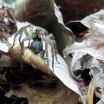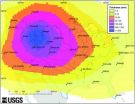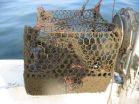(Press-News.org) Athens, Ga. – An invasive grass species frequently found in forests has created a thriving habitat for wolf spiders, who then feed on American toads, a new University of Georgia study has found.
Japanese stiltgrass, which was accidentally introduced to the U.S. in the early 1900s, is one of the most pervasive invasive species and has spread to more than a dozen states in the past century, particularly in the Southeast. Typically found along roads and in forests, it can survive in widely diverse ecosystems and has been found to impact native plant species, invertebrate populations and soil nutrients.
In a new study recently published in the journal Ecology, UGA researchers found that Japanese stiltgrass also is affecting arachnid predators: Lycosid spiders, commonly known as wolf spiders, thrive in the grass. As their numbers grow, more spiders then feed on young American toads, ultimately reducing the amphibian's survival wherever this grass grows.
John Maerz, an associate professor in UGA's Warnell School of Forestry and Natural Resources and one of the paper's authors, said they found the grass had the greatest negative impact on toad survival in forests where toad survival was naturally high.
"In other words, the grass is degrading the best forests for young toad survival," Maerz said. "Another important finding was that the invasive grass affects toads by changing interactions among native species rather than the grass having a direct effect on the native toads."
Jayna DeVore, who led the project while earning her doctorate in the Warnell School, said people often don't fully realize how much structural changes in an environment can affect how animals interact.
"Ecosystems are so incredibly complex that it can be surprisingly difficult to foresee just how environmental changes, such as an invasion, will affect organisms living in affected areas," said DeVore, who is now a postdoctoral fellow with the University of Sydney in Australia. "I think that one of the unique things about this study is that it not only documents the fact that this plant invasion reduces the survival of a native species, but also determines the mechanism through which that occurs."
Maerz has been interested in the effects of Japanese stiltgrass on forest ecosystems for years. When DeVore and Maerz originally found lower survival of American toads at eight locations in Georgia where stiltgrass is actively invading, they initially speculated that the grass was reducing the toads' food supply by reducing insect populations—few native insects eat the Asian grass. However, after noticing the wolf spiders routinely preying upon toads in invaded habitats, it began to click, Maerz said.
Spiders are incredible predators, he explained, and they eat everything—even other spiders. That typically keeps spider populations in check, Maerz said, but Japanese stiltgrass is "kind of like a tall shag carpet," and it provides the cannibalistic spiders refuge from one another. The accumulation of large, predatory spiders in these invaded habitats then results in higher mortality for small toads that have recently emerged from wetlands.
To test their hypothesis, DeVore and Maerz created cages where they could control the presence of stiltgrass and spiders. They found that spider densities were 33 percent higher and toad survival decreased by 65 percent in cages with the presence of stiltgrass. The presence of stiltgrass alone, in the absence of spiders, did not affect toad survival.
"Spiders are actually tremendously important and incredibly abundant predators on the forest floor, and they will eat many of the small species that live there, so this effect is unlikely to only influence toads," DeVore said. "And there are also other ways in which invasion by this Asian plant may influence species on the forest floor. We documented changes in invertebrate densities and soil characteristics that may affect other species that depend on these invertebrates for prey or are sensitive to changes in soil properties such as moisture and pH."
DeVore and Maerz are trying to determine whether the grass invasion is affecting other amphibian species in similar or predictable ways. It's "logistically impossible" to test the effects on an environmental change on every species that could be impacted, DeVore said, and even related species often react dramatically differently. The researchers hope to show that by accounting for certain aspects of the behavior and biology of a species, it will allow them to predict how they react.
INFORMATION:
The paper by DeVore and Maerz was featured on the cover of the July issue of Ecology and can be found online at http://www.esajournals.org/doi/full/10.1890/13-1715.1.
More wolf spiders feasting on American toads due to invasive grass, UGA study shows
2014-08-27
ELSE PRESS RELEASES FROM THIS DATE:
Orion rocks! Pebble-size particles may jump-start planet formation
2014-08-27
Rocky planets like Earth start out as microscopic bits of dust tinier than a grain of sand, or so theories predict.
Astronomers using the National Science Foundation's (NSF) Green Bank Telescope (GBT) have discovered that filaments of star-forming gas near the Orion Nebula may be brimming with pebble-size particles -- planetary building blocks 100 to 1,000 times larger than the dust grains typically found around protostars. If confirmed, these dense ribbons of rocky material may well represent a new, mid-size class of interstellar particles that could help jump-start ...
AGU: Yellowstone supereruption would send ash across North America
2014-08-27
WASHINGTON, D.C. – In the unlikely event of a volcanic supereruption at Yellowstone National Park, the northern Rocky Mountains would be blanketed in meters of ash, and millimeters would be deposited as far away as New York City, Los Angeles and Miami, according to a new study.
An improved computer model developed by the study's authors finds that the hypothetical, large eruption would create a distinctive kind of ash cloud known as an umbrella, which expands evenly in all directions, sending ash across North America.
A supereruption is the largest class of volcanic ...
'Junk' blood tests may offer life-saving information
2014-08-27
Tel Aviv — Some 30 percent of all positive hospital blood culture samples are discarded every day because they're "contaminated" — they reflect the presence of skin germs instead of specific disease-causing bacteria.
Rather than toss these compromised samples into the trash, clinicians may be able to use the resistance profiles of skin bacteria identified by these tests to treat patients with antibiotics appropriate to their ailment, Tel Aviv University researchers say. Dr. Gidi Stein and Dr. Danny Alon of TAU's Sackler Faculty of Medicine and the Department of Internal ...
Big data approach identifies Europe's most dangerous human and domestic animal pathogens
2014-08-27
The pathogens posing the greatest risk to Europe based upon a proxy for impact have been identified by University of Liverpool researchers using a 'big data' approach to scientific research.
The researchers from the University's Institute of Infection and Global Health ranked the top 100 pathogens affecting humans and the top 100 affecting domestic animals using a system which, they believe, will help governments across the continent plan for risks associated with the spread of infectious diseases, including as a result of climate change, and for biosecurity.
The top ...
Drug represents first potential treatment for common anemia
2014-08-27
(WASHINGTON, August, 27, 2014) – An experimental drug designed to help regulate the blood's iron supply shows promise as a viable first treatment for anemia of inflammation, according to results from the first human study of the treatment published online today in Blood, the Journal of the American Society of Hematology
Anemia is a condition that occurs when red blood cells are in short supply or do not function properly. When an individual has anemia, the body does not get enough oxygen, since there are fewer red blood cells to carry the iron-rich protein hemoglobin ...
Pacific plate shrinking as it cools
2014-08-27
HOUSTON – (Aug. 27, 2014) – The tectonic plate that dominates the Pacific "Ring of Fire" is not as rigid as many scientists assume, according to researchers at Rice University and the University of Nevada.
Rice geophysicist Richard Gordon and his colleague, Corné Kreemer, an associate professor at the University of Nevada, Reno, have determined that cooling of the lithosphere -- the outermost layer of Earth -- makes some sections of the Pacific plate contract horizontally at faster rates than others and cause the plate to deform.
Gordon said the effect detailed this ...
NOAA's Marine Debris Program reports on the national issue of derelict fishing traps
2014-08-27
Thousands of fishing traps are lost or abandoned each year in U.S. waters and become what are known as derelict traps, which continue to catch fish, crabs, and other species such as turtles. These traps result in losses to habitat, fisheries, and the watermen who depend on the resources--losses that are largely preventable, according to a newly published NOAA study.
The report, published in the Marine Pollution Bulletin, is the first of its kind to examine the derelict fish trap problem, and so-called "ghost fishing," nationally, and recommends actions to better manage ...
Taking aim at added sugars to improve Americans' health
2014-08-27
Now that health advocates' campaigns against trans-fats have largely succeeded in sidelining the use of the additive, they're taking aim at sugar for its potential contributions to Americans' health conditions. But scientists and policymakers are still wrangling over the best way to assuage the nation's insatiable sweet tooth, according to an article in Chemical & Engineering News (C&EN), the weekly news magazine of the American Chemical Society.
In the article, Stephen Ritter, a senior correspondent at C&EN, notes that growing evidence suggests the overconsumption of ...
Participants of cardiac clinic trials do not represent real world patients, study finds
2014-08-27
A new analysis of clinical trial participation in the largest ongoing observational study of U.S. heart attack patients has found participants are not representative of the larger patient base, according to a study led by Women's College Hospital cardiologist Dr. Jay Udell. The study authors call into question the general applicability of the findings to the wider population, and suggest the use of broader enrollment criteria and existing patient registries to increase trial participation.
"We know that clinical trials can be tremendously expensive and a huge burden on ...
Promising new cancer therapy uses molecular 'Trash Man' to exploit a common cancer defense
2014-08-27
While many scientists are trying to prevent the onset of a cancer defense mechanism known as autophagy, researchers at Virginia Commonwealth University Massey Cancer Center are leveraging it in a new therapy that causes the process to culminate in cell death rather than survival. The novel treatment strategy targets the p62 protein, which is often referred to as the "Trash Man" due to its role in disposing unwanted cellular proteins during autophagy. Results from preclinical experiments suggest this experimental treatment approach could be particularly effective against ...




